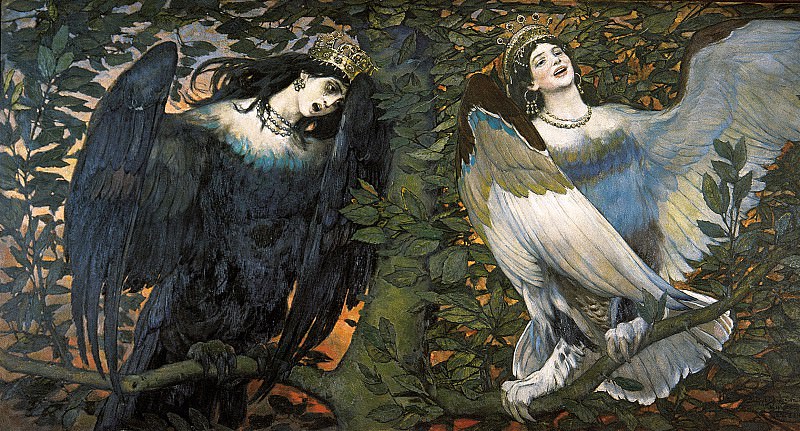Sirin and Alkonost. Song of joy and sadness Viktor Vasnetsov (1848-1926)
Viktor Vasnetsov – Sirin and Alkonost. Song of joy and sadness
Edit attribution
Download full size: 2321×1250 px (1,0 Mb)
Painter: Viktor Vasnetsov
V. M. Vasnetsov’s works are fairy tales, bylinas, myths, historical and folklore subjects. Among his works are frequent references to ancient Slavic pagan themes. The famous painting "Song of Joy and Sorrow" finished in 1896 is not an exception. In the center of the picture is a tree, on the branches of which sit two half-birds - Alkonost and Sirin. The first bird promises paradise sometime in the future.
Description of Victor Vasnetsov’s painting "Song of Joy and Sorrow" (Sirin and Alkonost)
V. M. Vasnetsov’s works are fairy tales, bylinas, myths, historical and folklore subjects. Among his works are frequent references to ancient Slavic pagan themes. The famous painting "Song of Joy and Sorrow" finished in 1896 is not an exception.
In the center of the picture is a tree, on the branches of which sit two half-birds - Alkonost and Sirin. The first bird promises paradise sometime in the future. The second sings that paradise has already been, and it is lost. Depicting them as half-birds-half-human is traditional. Vasnetsov allowed a deviation from the myth - according to the legend Alkonost and Sirin were both sexually mated. In the artist, however, they have the heads of beautiful girls in crowns.
The bird Alkonost expects a future paradise. She has a smile on her face, multi-colored wings depicted in light colors. One legend says that the singing of this half-bird comforts the afflicted. Another legend says its singing is so beautiful that he who hears it will forget everything. The artist succeeded in conveying the bird’s mood - Alconost does not feel herself when she sings.
Cyrene is bound by grief. If the Alconost reveals itself, Sirin bows its head down. Plumage is depicted in dark colors. The bird’s grief is further emphasized by the bruises under her eyes. The singing of the Sirin bird is believed to bring oblivion and death.
The contrast is heightened by the background. The birds sit on different branches of the same tree. Next to the Sirin bird, the leaves are blackened and shriveled up, and there are very few leaves left.
Around Alconost the leaves blossom in lush color, as if rejoicing in life and the paradise to come.
The painting, painted in oil on canvas, is part of the permanent exhibition of the State Tretyakov Gallery. It is one of the most famous works of the artist. In 1899, the young symbolist poet Blok dedicated one of his poems to the picture.
Кому понравилось
Пожалуйста, подождите
На эту операцию может потребоваться несколько секунд.
Информация появится в новом окне,
если открытие новых окон не запрещено в настройках вашего браузера.
You need to login
Для работы с коллекциями – пожалуйста, войдите в аккаунт (open in new window).

















COMMENTS: 2 Ответы
Картины из детства
Очень интересная картина
You cannot comment Why?
Alkonost, on the right, contrasts sharply with Sirin. Her wings are a vibrant mix of white and blue, and her expression is one of joyous exaltation. Her mouth is open in song, her head tilted back, and she too is adorned with a crown and necklaces.
The painting is rich in symbolism, drawing from Slavic mythology. Sirin represents the sorrowful, earthly existence, while Alkonost embodies the divine and heavenly joys. The contrasting poses and expressions of the two figures create a powerful dialogue between sadness and happiness, grief and elation. The dense, dark greenery surrounding them could symbolize the earthly realm or the mysteries of nature, while the dappled light suggests a divine or spiritual presence. The crowns and jewelry allude to their celestial or regal nature, but also the burdens that come with such status. The painting explores the dualistic nature of human experience, where joy and sorrow are inextricably linked, and the ephemeral nature of both emotions.